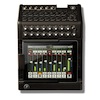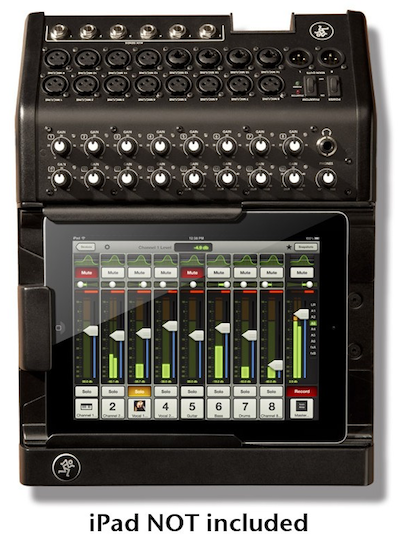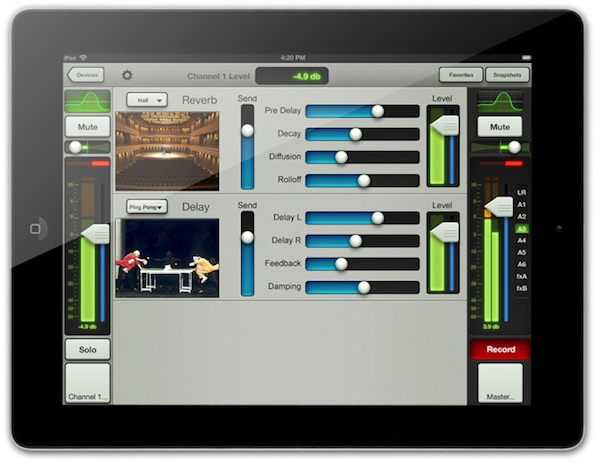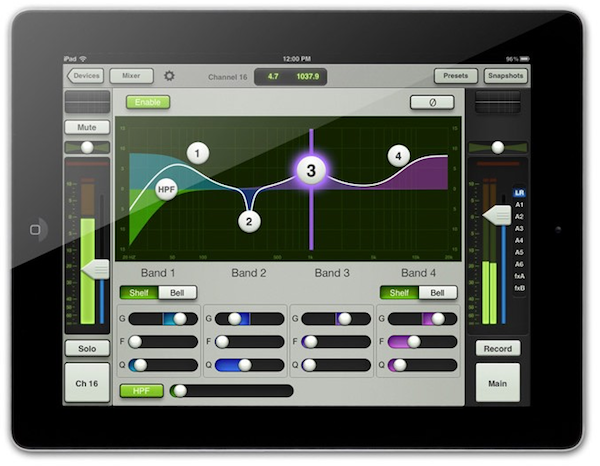MACKIE DL1608 REVIEW
Posted on Mon 11 February 2013 in entries
 You can read more reviews like this, listen to Tony’s productions, purchase synth patches and more at his personal site -> Tony Long Music.
You can read more reviews like this, listen to Tony’s productions, purchase synth patches and more at his personal site -> Tony Long Music.
MACKIE DL1608 - INTRODUCTION
Mackie, who are renowned for their quality speakers and mixers, have come up with an idea that allows you to mix easily and wirelessly away from the stage with an iPad. Introducing the DL1608 digital mixer! Although announced at NAMM 2012, the 2013 industry show has introduced two further products based on this idea in the form on the Behringer (who love to copy ideas from other manufacturers!) iX16 iPad Mixer and the Mackie DL806, which is essentially a smaller 8 channel version of the 1608. You just can't help but notice how iOS devices are becoming more and more popular in serious professional music applications, providing touch-screen functionality as well as a large full-colour display for detailed feedback, which is undeniably more useful than the small LCD screens of the past. Maybe there will come a time when every piece of hardware has a facility to work with a tablet of some description.
Combining the quality of Mackie hardware with an iPad and an app sounds like a recipe for something special to me. I therefore thought I would take a look at one to give me a taste of the future.
 ](https://www.absolutemusic.co.uk/mackie-dl1608-digital-mixing-console-requires-ipad.html)
](https://www.absolutemusic.co.uk/mackie-dl1608-digital-mixing-console-requires-ipad.html)
Like me, you may wonder why such a piece of kit costs around £1000 when to some extent, it is just the shell of a digital mixer that requires an iPad to sit at its heart to control it. I am sure that the cost of developing this futuristic technology doesn't come cheap but in comparison with Roland's app for the Jupiter 50/80, the difference is that the Mackie DL1608 needs the iPad as an essential part of its requirements. This means that if you don't have an iPad, you have more money to find on top of the £1000(ish) for the mixer - so is it worth it?
Well, to answer that question you have to think about the fact that you can detach the iPad from the DL1608 and wirelessly control a mix in real-time out in the audience, so you can make tweaks from the listener's point of view. In fact (would you believe it!), you can actually control your mix with up to 10 iPads at once! Why would you want to do this? Well, I guess you could have multiple iPads set up for different parts of the app, allowing you to have a dedicated screen for controlling individual parts of the mix. Or each member of a band could have their own iPad so that they can have full control over their own monitor levels and EQ. Not a bad idea at all.
With the Mackie DL1608, no longer does the mixing engineer need to sit behind a desk all night in a fixed position. They are now free to move about and listen and adjust the mix and they don't need to move back and forth from the stage to the back of house after making each tweak. They also do not need to set up a long and expensive multicore. I found it interesting that one mixing engineer was so pleased about the release of the DL1608 that he said that for the first time in sixteen years he can now sit with his family!
With the Mackie DL1608, all the processing is done in the mixer itself and the iPad controls it. Therefore some of the cost must contribute towards the built-in DSP, which provides outstanding EQ, compression and gate plug-ins, as well as high-quality reverb and tap delay.
MACKIE DL1608 - CONNECTING UP
The free app called Mackie Master Fader is available from the iTunes store. It was quick to download and the whole set-up process was surprisingly fast. Simply attach your iPad, switch it on, load up the Master Fader app and within seconds you'll be able to see the interaction. As I turned up the gain knobs on the DL1608 I could instantly see the mirrored movement on the faders, which are displayed on the iPad.
It's worth noting (because you may not think about it straight away), but in order to get the wireless connection, you will need to connect the DL1608 mixer to a wireless router. There is an Ethernet port on the mixer provided for this.
Whilst the iPad is docked in the DL1608 it will charge, which in my opinion is absolutely essential. After all, if your iPad dies, most of your mix control dies with it! The mixer can be secured with a Kensington Lock and better still you can also secure your iPad in the dock of the mixer with the hardware provided.
In the box (apart from the DL1608) you will find DL1608 padlock, a 12V DC power supply and a limited 1-year warranty (don't forget that you can also increase your warranty to 3 years with Absolute Music by signing up to their free VIP Club - click here for more details). It will take all three versions of the iPad and the mixer comes with adaptors to accommodate the three different sizes.
MACKIE DL1608 - HARDWARE
The Mackie DL1608 hardware is fairly small and portable and weighs less than 7 lbs. but it is solidly built with quality controls and there are no hardware faders. If you have a look around the back you will see that it has 16 inputs powered by Onyx mic preamps, which have 60dB of gain. The DL1608 also has Cirrus Logic converters which have a dynamic range of 114dB (that should give you some headroom). Closer inspection shows that these are 12 regular XLR inputs and 4 XLR/quarter inch combo inputs and they all accept both line and mic signals. There are also stereo XLR master outs, six aux send jack outputs and a headphone out with its own gain control. Strangely enough there are also 16 hardware knobs for manual control, but thinking about this, as with all stage gear there will no doubt be times when things go wrong. You may lose the wireless connection or there could be something that goes wrong with your iPad for example. At least with these physical controls you have some fall-back, so that makes perfect sense.
MACKIE DL1608 - SOFTWARE MIXING
I think that most apps on the market are very clear and easy to follow and luckily the Mackie Master Fader app is no different. It is well laid out and excellently designed. It doesn't look or feel in any way cluttered and allows you to get on with the job in hand. Everything responds quickly, smoothly and easily to the touch. I immediately loved it and thought how much better it was over the hardware equivalent and other computer software mixing applications such as those found on many popular DAWS.
Every channel in the Master Fader app gives you a fader plus Mute, Pan and Solo buttons. If you touch the EQ curve at the top, it takes you to a plug-ins page. Every channel has a four-band equaliser with a sliding high pass filter. On my own mixer I have some channels that are linked, but I was unable to find a way to link two channels together here. Perhaps a later software upgrade may make this available. What's a nice touch (especially in dark environments) is that everytime you adjust a control on the iPad, it glows so that you can tell exactly which parameter you are interacting with.
 ](https://www.absolutemusic.co.uk/mackie-dl1608-digital-mixing-console-requires-ipad.html)
](https://www.absolutemusic.co.uk/mackie-dl1608-digital-mixing-console-requires-ipad.html)
What I didn't realise here to start with is that you need to flick the pages to get to the other screens and plug-ins. If you flick side to side (swipe horizontally) you can access the fader banks, but as you flick up it takes you to a Channel Gate and Compressor page and flicking again takes you to a global Reverb and Delay page - it is really easy to navigate.
The Mackie Master Fader app also a 31-band graphic equaliser and a compressor/limiter for the main L/R output and all the aux outs. You adjust this band by band, by moving the 'sliders' up/down, or simply by pressing on the touch screen and drawing the desired curve. You can then store these as presets for recall or later use.
It doesn't matter whether you have an iPad or an iPad mini because both are compatible with the DL1608. Using up to 10 of them at once allows multiple engineers to control the mix and as mentioned, probably the best use of this is that each band member could control their own monitor mix. Recent updates to the software include some new plug-ins for channel processing such as the new vintage EQ.
The other thing I like about this app is that it can store presets that you can load into any channel. Mackie even provide a few of their own to get you started. If you want to, you can also name the channels and have a picture associated with them. Well, as it is an iPad, I decided to take some pictures with it, of my own gear. That made sense to me as it clearly showed which bit of my kit I had in each of the channels. No doubt if you are in a band, mixing, you could have a picture of each member of the band if you wished.
MACKIE DL1608 - EQ
You can look at the EQ screens by simply tapping on the respective channel's EQ icon, which is located above the mute buttons. There are four types of icon and the EQ curve illuminates in green when it is engaged and grey when it is disengaged. The other icons represent the EQ curve in relation to whether or not the High-Pass Filter is off or on.
As you go through to the EQ page, you can clearly see that you have a four-band EQ, which has points that you can easily drag. As well as adjustable Q values, there are also bell or shelf EQ types, selectable with associated buttons. At the bottom of the page is the high-pass filter option. The four-band EQ has high shelving, high-mid peaking, low-mid peaking and low shelving bands. These are used to either boost or cut all frequencies past a specified point. Each of the four bands also have adjustable gain and frequency and on bands two and three you get adjustable Q bandwidth.
 ](https://www.absolutemusic.co.uk/mackie-dl1608-digital-mixing-console-requires-ipad.html)
](https://www.absolutemusic.co.uk/mackie-dl1608-digital-mixing-console-requires-ipad.html)
I found that you have to be careful not to overdo it here - you don't want too much EQ. There seems to be quite a bit of boost and cut available and if you go mad with it, you risk ruining the mix. Moderation is the key word here.
Lastly there is a Polarity Invert button, which allows individual channel polarity inversion of 180 degrees. That sounds like something Dr Who would have said but as I understand it, if you are working with live signals and you have a few mics (e.g. on a drum kit), it is possible to get phase problems. Reversing the polarity here could help you get a better sound.
MACKIE DL1608 - GATE, COMPRESSION, REVERB AND DELAY
You certainly get some quality effects with the Mackie DL1608 and all the processing is carried out using the mixer's internal DSP, which does not put any strain on the iPad's resources.
I love the Gate facility here as it is very easy to use and is excellent for eliminating leakage from mics, for example. Mackie sensibly put Compression on the same screen page so at a glance you can see what is going on and make adjustments to improve the sound and remove problems. For the Gate you get simple, clear slider controls to adjust the Threshold, Range, Attack, Hold and Release. Alternatively, on the graph image, you can move the Threshold and Ratio balls.
The Compressor has a simple on and off switch. Similarly, you can adjust it by using the Gain, Threshold and Ratio balls. There is also a soft or hard knee switch to set the shape of the gain reduction curve.
Scroll down further again and you will find reverb and delay. There are nine reverbs: Plate, Ambience, Small Room, Medium Room, Large Room, Hall, Cathedral, Gated Reverb and Spring. For each of these you get a set of sliders to adjust Pre-delay, Damping, Decay, Roll-off and Release as well as a master level fader.
There are five types of delay: Mono, Tape Echo, Stereo, Ping-Pong and Multi-Tap. For the slider controls you get Delay Left, Delay Right (for manually setting the repeat rate), Feedback and Damping.
MACKIE DL1608 - TOTAL SNAPSHOT RECALL
They certainly come up with some names for these functions, but Total Snapshot Recall allows you to recall mix functions quickly and easily. Mackie say that you can save and access sound check settings for multiple bands, complex song mixes and previous mixes from challenging venues.
MACKIE DL1608 - RECORDING AND PLAYBACK
When you think about this incredible integration of the iPad with something as good as a Mackie mixer, it really gets you thinking about the possibilities for the future of live mixing. Don't forget how regularly apps get updated these days with improvements and additional facilities!
Anyway, looking at today and what an iPad can do, you may be thinking about playing mp3 files, backing tracks, recording to the iPad and integrating music from your other apps. Thankfully the DL1608 can do all of these extremely easily. You also can record your highly refined mix directly to your iPad and if you want to, you could upload it and share it with others.
However, I noticed that recording does have one problem: you cannot do it wirelessly because there is insufficient bandwidth. With regards to playback though, there is a special channel assigned to your iPad especially for this purpose. What this means is that you can play back your mp3 backing track or Garage Band song and add it in with your live mix without using one of the 16 mixer channels - great stuff.
MACKIE DL1608 - CONCLUSION
Well, I loved playing around with the DL1608. It has an excellent build and sound, sets up easily and quickly and puts a whole new slant on live mixing as well as being extremely portable and compact. It has an easy learning curve and will not take you long to become familiar with all of the iPad's software pages. The DSP effects are great and so easy to control with the iPad.
If you are very used to using hardware faders, you may find it strange moving to a touch screen but after a while it becomes second nature. The inputs are all mono so if you want to add a synth for live performance you would need to split it across two channels. Mackie offer a way for users to suggest improvements on their forum and the stereo channel seems to be a popular request.
The iPad wireless control is without doubt the DL1608s main selling point. Of course, a wireless control on a touch screen may not suit everyone and don't forget that wireless control is only as reliable as the router it is connected to. However, like I have said, everything moves on with improvements and enhancements and what is already an extraordinary, useful and exciting piece of kit today will evolve tenfold now that the idea is a reality. Already it is being copied and they say that to copy is the sincerest form of flattery.
For more information on the Mackie DL1608 digital mixer, click the link below or give us a call on 01202 597180.
Mackie DL1608 & AKG D5 Mic Bundle - SAVE £££s!!! - More Info/Buy
Mackie DL1608 & DLM12 PA System - SAVE £££s!!! - More Info/Buy
******If you're interested in buying and you have seen it cheaper elsewhere, please call us or use our
As well as receiving our first rate customer service you can also claim money off your next purchase with our loyalty points scheme and receive a 3 year warranty if you sign up to our FREE VIP Club (click here for more infomation). Many of our items also come out on a FREE next-day delivery service to mainland UK customers, so you won't be left waiting!
Also, if you want to keep up with all our latest offers, competitions, news and videos, why not follow us on Facebook and Twitter?



